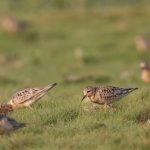By: Varinia Sagastume, Coastal Solutions Fellows Program
Guatemala’s Pacific coast ecosystems provide resting and feeding stopover areas for at least 37 species of migratory shorebirds; and are a breeding area for five species. However, this flat region that was once covered with forests, mangroves, and a great diversity of wetlands was transformed into a mix between urban and hotel areas, vast agricultural plantations, pastures for cattle, and ponds for salt production and aquaculture.
The transformation of the landscape required shorebirds to look for alternative sites to survive the migration, including shrimp farms. Therefore, collaboration with producers is key to increase their chances of survival. The first step was to involve the farmers and train them to identify the species, their habits, the migratory seasons, and the relationship with productive activities. Most of them thought that the birds they saw were all the same. They now recognize their characteristics, know their names, and get involved in conservation efforts.
Cross-sectoral collaboration to promote migratory bird-friendly practices
The farmers of the Mayasal farm have become unexpected allies for the conservation of the shorebirds that visit this place. After two years of continuous work, they now recognize the importance of their site for shorebirds and collaborate with the collection of data. This teamwork contributed to developing the necessary actions for the coexistence of birds and shrimp farming.
The Mayasal farm has a semi-intensive production system characterized by ponds with an earthen floor that, after the shrimp harvest, provides shorebirds with a temporary habitat for resting and feeding. With this knowledge in mind, we worked in a collaboration between the company Acuamaya (company that manages the Mayasal farm) and the Coastal Solutions Program, with the objective of identifying a series of best practices for mutual benefit to birds and producers.
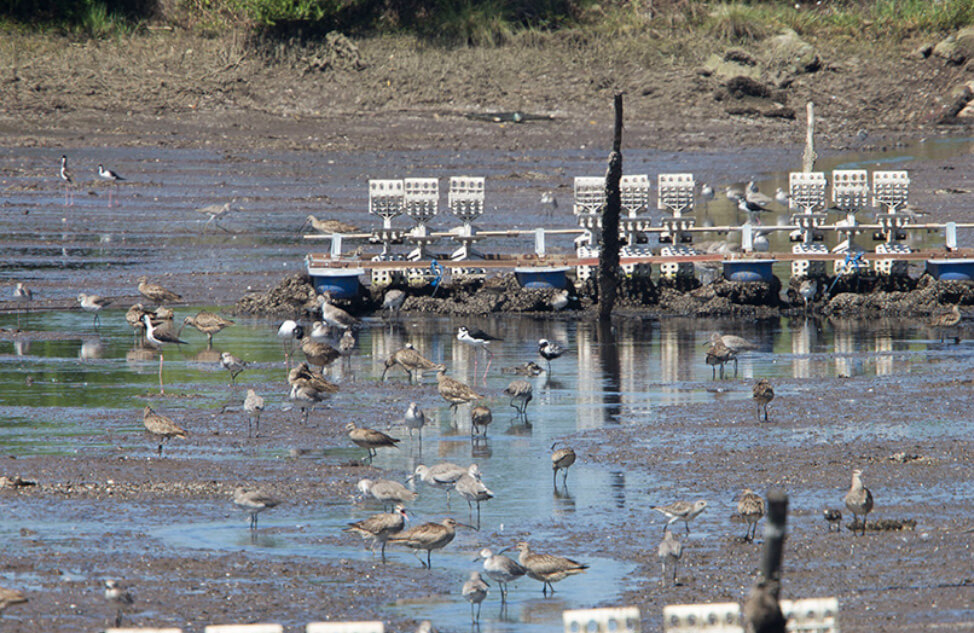
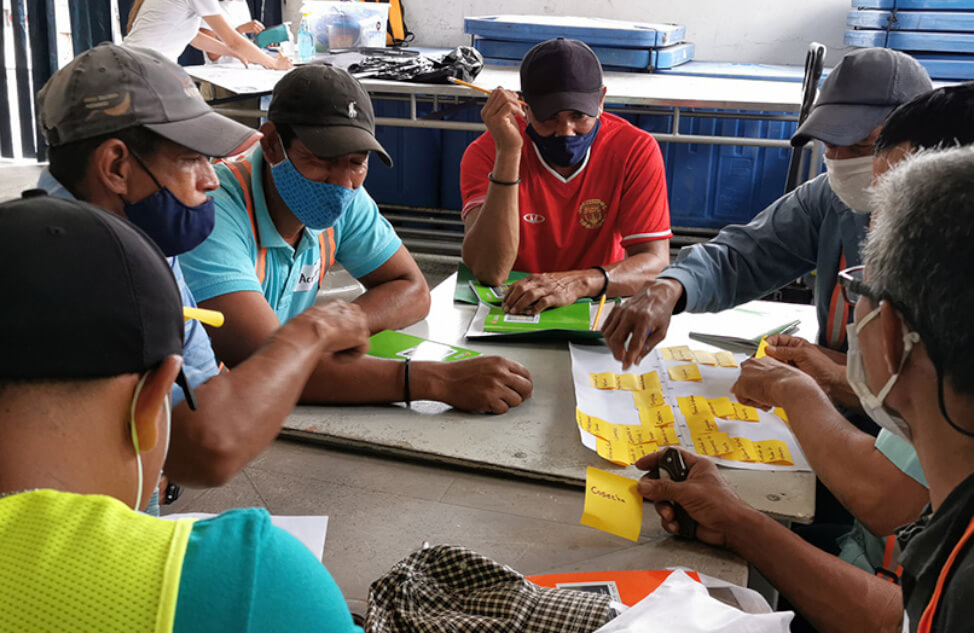
Left: Shorebirds in a shrimp pond. Photo: Jorge Rodriguez. Right: Workers of the Acuamaya shrimp farm during the workshop. Photo: Varinia Sagastume
Through workshops and inclusive processes, the main threats and potential solutions were identified for shorebird conservation in shrimp farming. Strategies were developed with a common vision to protect the natural resources that sustain both birds and shrimp farming. Four strategies were identified: 1) Capacity building, awareness raising, and education; 2) Protection and restoration of coastal wetlands; 3) Improved water management; and 4) Development of bird-friendly shrimp farming. The latter is focused on reducing disturbance and improving the quality and availability of habitat for birds using shrimp ponds.
Currently, more than 130 species of birds can be found in Mayasal. It is also visited by at least 26 species of migratory shorebirds including Whimbrel (Numenius phaeopus), Red Knot (Calidris canutus), Hudsonian Godwit (Limosa haemastica), and Ruff (Calidris pugnax), reported last in Guatemala in 1974.
In the long term, it is expected that the implementation of strategies and bird monitoring in shrimp farms will serve as an indicator of sustainability and the health of coastal ecosystems adjacent to the farms. “Bird welfare has a lot to do with the welfare of the company. The birds are telling us that we have life here, that we have sustainability here,” said Alexander “Zandy” DeBeausset, Acuamaya’s Production Manager.
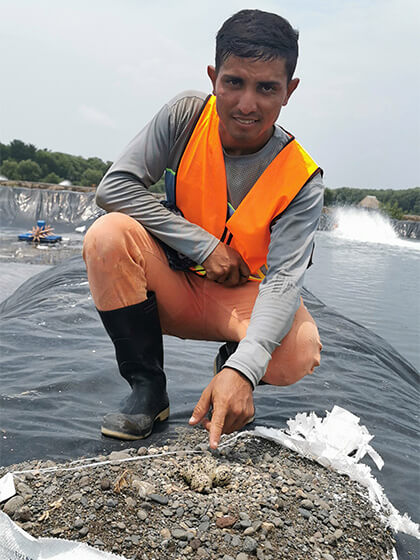
Farm worker finding a nest of Black-necked Stilt. Photo: Varinia Sagastume.
Nest protectors and citizen science
The collaboration with this productive sector detected another use that some species give to this alternative habitat, as a breeding site for waterfowl and shorebirds. The first nesting record of Wilson’s Plover (Charadrius wilsonia) for Guatemala was documented here and it is the only known site in the country where the Roseate Spoonbill (Platalea ajaja) nests. Other nesting species that can be found here include Black-necked Stilt (Himantopus mexicanus), White Ibis (Eudocimus albus), and eight species of herons.
Participation in monitoring activities increased through the citizen science project “Report your nest” — a voluntary program aimed at farm security workers with the objective of finding bird nests while patrolling. This program improved the perception of the biodiversity in the area. Eleven people reported 31 bird nests while patrolling. In 2021, 23 nests of Black-necked Stilt were reported on the Mayasal farm. While, in 2022, 51 nests of this species were reported by the “nest protectors”. Thanks to this program, information and interest were created in the protection of shorebird nesting sites in artificial habitats.
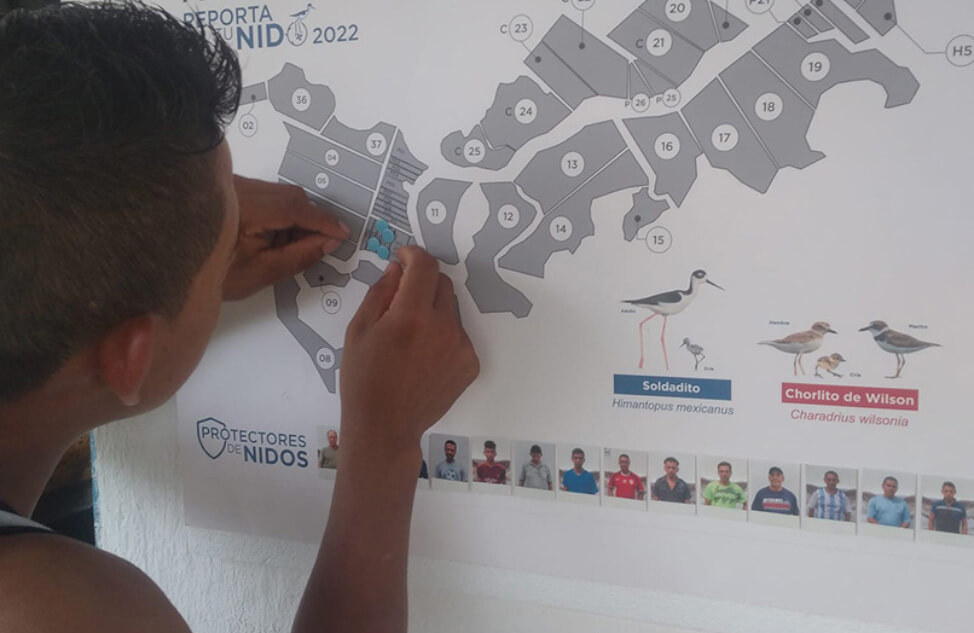
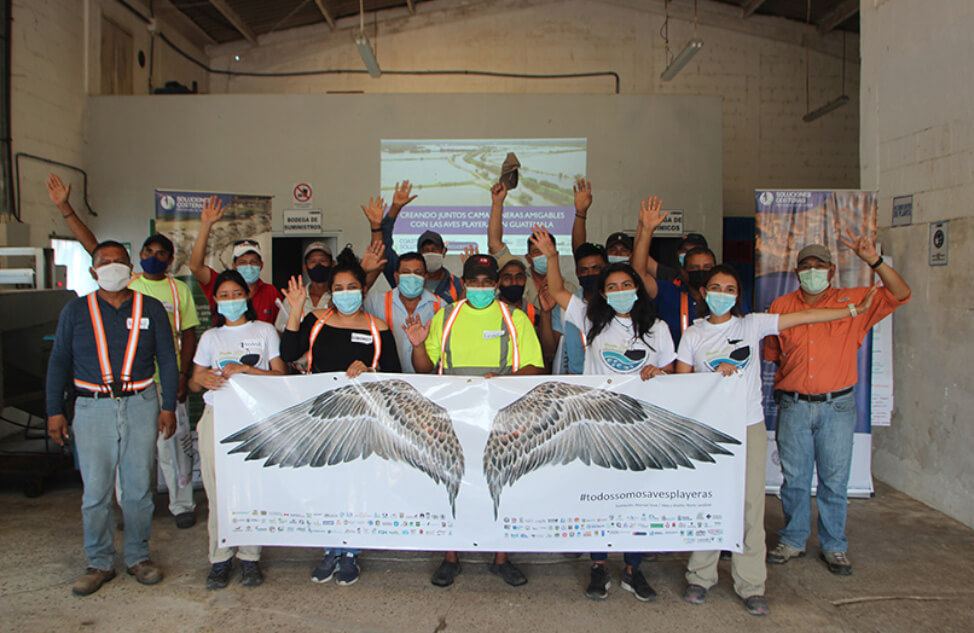
Left: Farm worker marking a nest on the map. Photo: Varinia Sagastume. Right: Workshop with workers of the Acuamaya shrimp farm. Photo: Jorge Rodriguez.
Hope for shorebird conservation in Guatemala
Workshops were replicated in other shrimp farms in Guatemala’s Pacific coast to continue the exchange of knowledge allowing common-ground solutions that benefit birds and shrimp producers. “These workshops taught us what things are good for the birds, what things the birds teach us that are good for us, and also have a better quality of work by giving the birds a better quality of life as well,” said Edwin Portillo of the San José shrimp farm.
All this work has shown encouraging results, since learning about birds extended beyond the farmers, reaching their families. José Daniel, just 9 years old, grandson of the farm manager, still cannot read, but he has already learned to identify bird species using the photographs of the “”. Now he visits the farm with his family and full of emotion repeats the names of the birds he observes: Black-necked Stilt, Green Kingfisher (Chloroceryle americana), Yellow-crowned Night-Heron (Nyctanassa violacea).
Bringing this knowledge closer to producers has helped to raise awareness and let them recognize which actions may affect birds and what they can do to care for them. With rapidly declining shorebird populations, these people represent hope and an example to follow for the entire shrimp industry and for conservation efforts in places where their natural habitats have been lost.
Cover photo. Curlews resting in shrimp ponds. Photo: Varinia Sagastume





